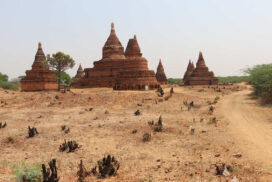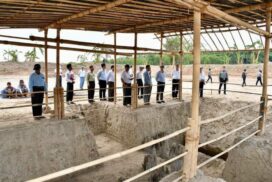In the heart of the Bagan region, a plethora of ancient stupas and temples have flourished, testifying to the virtuous acts of the devoted Bagan community. These sacred structures, now recognized as Myanmar’s cherished cultural heritage, have suffered a fate wherein half of them vanished due to the passage of time, natural catastrophes, and human activities spanning various eras.
The architectural marvels of Bagan’s existing ancient buildings showcase a blend of Indian influences and the exquisite cultural craftsmanship of Myanmar, a testament to the benevolence of both monarchs and citizens. These unparalleled architectural achievements continue to captivate archaeologists, scholars, historians, and explorers from around the world, vividly portraying the zenith of Theravada Buddhism in ancient Myanmar in the Bagan era.
Historical records indicate that the diligent hands of Bagan’s people erected around 5,000 stupas and temples, adorning a 20-square-mile expanse. Yet, lamentably, throughout a millennium, a significant portion of these spiritual sanctuaries has vanished into the annals of history. This loss unequivocally translates to a depletion of Myanmar’s cultural legacy.
In parallel, local authorities and concerned entities must adopt preemptive strategies to shield these time-honoured structures from natural calamities such as earthquakes and torrential downpours, preventing their degradation and eventual collapse. Just this year, Cyclone Mocha unleashed its fury upon various regions, including Bagan’s cultural heart, inflicting damage, particularly in Rakhine and Chin states. Torrential rains infiltrated the precincts of these ancient sanctuaries, causing distressing harm.
The pivotal moment came on 6 July 2019, when UNESCO bestowed World Heritage status upon the Bagan ancient cultural region. This recognition, achieved with unanimous approval from the UNESCO World Heritage Committee’s 21 member nations, extended to individual pagodas as well as the encompassing Bagan expanse. As a result, the inhabitants of Bagan bear the responsibility of safeguarding their cultural precinct, averting the perilous decline of their ancient heritage.
In parallel, local authorities and concerned entities must adopt preemptive strategies to shield these time-honoured structures from natural calamities such as earthquakes and torrential downpours, preventing their degradation and eventual collapse. Just this year, Cyclone Mocha unleashed its fury upon various regions, including Bagan’s cultural heart, inflicting damage, particularly in Rakhine and Chin states. Torrential rains infiltrated the precincts of these ancient sanctuaries, causing distressing harm.
A systematic dredging endeavour of drainage channels, both inlet and outlet, serves the purpose of maintaining proper water flow throughout the Bagan ancient cultural region. This essential undertaking, however, must meticulously adhere to established protocols and regulations to allay apprehensions about inadvertently harming these venerable structures.
In the spirit of foresight, comprehensive preservation strategies should be implemented to ensure the endurance of Bagan’s ancient edifices while preserving their original artistic integrity. After all, Bagan stands as a jewel in Myanmar’s crown, a cultural heritage treasured not only by its citizens but also by the global community.














